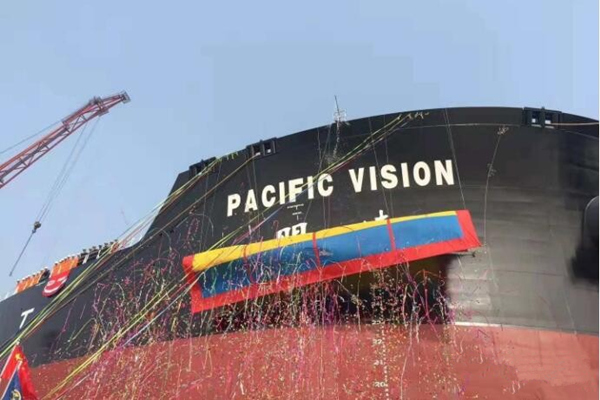On November 28, 2018, the world's first 400,000-ton intelligent super-large ore ship (VLOC) "PACIFIC VISION", which was tailor-made by Shanghai Overseas Takahashi Shipbuilding Co., Ltd. for China Merchants Energy Transportation Co., Ltd., was named in Shanghai. Delivery, which marks the full development of China's smart ships into the new era of 1.0.
The world's first 400,000-ton intelligent super-large ore ship named "PACIFIC VISION" was delivered. This ship is the first demonstration ship of China's intelligent ship 1.0 research and development, which has realized auxiliary automatic driving, energy efficiency management, equipment operation and maintenance, ship-shore integrated communication, The five intelligent module functions, such as cargo liquefaction monitoring, comply with CCS Classification Society's "Smart Ship Code" and comply with the requirements of the International Ship Monitoring - Reporting - Verification (MRV) rules.
The ship was awarded the CCS classification society i-ship (N, M, E, I) and DNV GL classification society Smart Ship class symbol, the first intelligent ship certified by both classification societies, also DNV The world's first smart ship certified by GL classification society.
The world's first 400,000-ton intelligent super-large ore ship named PACIFIC VISION was delivered. The smart ship achieved six breakthroughs:
First, the concept of “platform + application” was first proposed and applied to the ship. The network information platform unified the collection, processing and analysis of the ship's sensory information, and provided operational environment data to each intelligent system to solve the problem of ship-wide information duplication. A series of problems such as collection, signal standards are not uniform, and ship system expansion is insufficient.
Secondly, for the first time, it has the function of assisting collision avoidance decision in open water, which can provide the crew with anti-collision suggestions to help solve the problem of the ship's misoperation and leakage operation affecting the safety of the ship's navigation, and lay a technical foundation for the next step of realizing the ship's independent collision avoidance.
The third is to realize the ship-to-ship communication for the first time, solve the problem of direct communication between the ship and the ship at sea, and pave the way for realizing the collision of the ship in the future.
The fourth is to realize the mineral liquefaction monitoring function for the first time. By monitoring the degree of liquefaction of minerals in the cargo tank, it provides suggestions to the crew to solve problems such as iron ore, nickel ore and other easily liquefied minerals affecting ship stability and improve the safety of navigation.
The fifth is to realize the functions of lightweight transmission of ship-to-shore communication, encrypt and encrypt the data and then return it to the shore, which provides a reliable data source for the future construction of shore-based data centers.
Sixth, the smart ship symbols of CCS and DNV GL were obtained at the same time.
It is reported that the "Mingyuan" is the latest second-generation 400,000-ton VLOC, mainly used for iron ore transportation from Brazil to China.
The ship has a total length of 362 meters, a width of 65 meters, a depth of 30.4 meters, a structure of 23 meters, a speed of 14.5 knots, and a life of 25,500 nautical miles. In addition to its intelligence, the ship is designed to meet CSA2, LNG-Ready, cargo liquefaction. , one-person bridge, environmentally friendly and other specifications and standards. The whole ship has a total of 7 cargo tanks and 1 LNG tank. It adopts energy-saving and environmentally-friendly ultra-long-stroke diesel engines, high-voltage shore power, and two-way optimization of speed and speed. It uses high-efficiency propellers and front-mounted guide wheels to install energy-saving devices. Economic, green, environmental protection, energy saving, and safety.
The port of destination for the “PACIFIC VISION” was the Ponta Da Madeira in Brazil.

